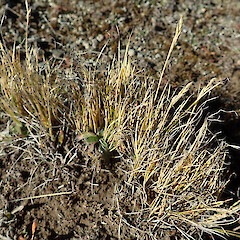Carex muelleri
Common name
Mueller’s sedge
Synonyms
Carex viridis Petrie
Family
Cyperaceae
Flora category
Vascular – Native
Endemic taxon
Yes
Endemic genus
No
Endemic family
No
Structural class
Sedges
NVS code
The National Vegetation Survey (NVS) Databank is a physical archive and electronic databank containing records of over 94,000 vegetation survey plots - including data from over 19,000 permanent plots. NVS maintains a standard set of species code abbreviations that correspond to standard scientific plant names from the Ngä Tipu o Aotearoa - New Zealand Plants database.
CARMUE
Chromosome number
2n = c.70
Current conservation status
The conservation status of all known New Zealand vascular plant taxa at the rank of species and below were reassessed in 2017 using the New Zealand Threat Classification System (NZTCS) – more information about this can be found on the NZTCS website. This report includes a statistical summary and brief notes on changes since 2012 and replaces all previous NZTCS lists for vascular plants.
Please note, threat classifications are often suggested by authors when publications fall between NZTCS assessment periods – an interim threat classification status has not been assessed by the NZTCS panel.
- Conservation status of New Zealand indigenous vascular plants, 2017 . 2018. Peter J. de Lange, Jeremy R. Rolfe, John W. Barkla, Shannel P. Courtney, Paul D. Champion, Leon R. Perrie, Sarah M. Beadel, Kerry A. Ford, Ilse Breitwieser, Ines Schönberger, Rowan Hindmarsh-Walls, Peter B. Heenan and Kate Ladley. Department of Conservation. Source: NZTCS and licensed by DOC for reuse under the Creative Commons Attribution 4.0 International licence.
2017 | Not Threatened
Previous conservation statuses
2012 | Not Threatened
2009 | Not Threatened
2004 | Sparse
Distribution
Endemic. South Island, in the east from Marlborough (upper Wairau River) to Otago.
Habitat
A species of upper montane river flat, lake margin and shallow tarn habitats within tussock grassland. It seems to prefer seasonally wet habitats.
Detailed description
Rhizomatous; pale yellow-green, whitish-green to green tufted and swarding sedge. Rhizome 2–3 mm diameter, rather woody, covered in closely sheathing brown scales. Culms stiffly erect, 60–450 × 0.5–1 mm, > leaves, terete, flattened or plano-convex above, terete below, rather wiry, glabrous; basal sheaths dark grey-brown or reddish brown. Leaves 80–350 × 0.5–15 mm, plano-convex or with the upper surface slightly concave, lamina grooved along back, flattened near tip, occasionally scabrid along the margins. Inflorescences almost dioecious, with plants either mostly male or female; males with sparse female flowers near inflorescence apex, females with males in the same position. Inflorescence an erect, linear, continuous, compound spike 15–40 × 4 mm. Spikes 5–10, more or less contiguous, pale, straw-coloured to almost grey-green. Subtending bracts glume-like, rather long-awned, though not > inflorescence. Glumes more or less the same length as the utricles, linear-lanceolate, acuminate or awned, rather membranous to chartaceous, pale green to pale brown or hyaline. Utricles 3.5–4.5 × 1–1.2 mm, plano-convex, narrow-lanceolate, strongly nerved on the flat face; beak 1.5–2 mm long, tapering, with finely scabrid wings and an oblique, bifid orifice; stipe 0.5–1 mm, hardly contracted. Stigmas 2. Nut c. 2 mm long, brown, oblong-obovoid, smooth, glossy.
Similar taxa
A very distinctive species easily recognized by its rather tall whitish-green, yellow-green to green tufted culms and leaves, creeping habit, and narrowly erect almost dioecious inflorescences. It is perhaps most similar to C. kaloides Petrie which differs by its greater stature, orange yellow, reddish-yellow to orange culms and leaves, longer, often paniculate inflorescence and broader, larger, rather more finely nerved utricles.
Flowering
October–January
Fruiting
October–June
Life cycle
Nuts surrounded by inflated utricles are dispersed by granivory and wind (Thorsen et al., 2009).
Propagation technique
Easily grown by division of whole plants and fresh seed. Because plants are virtually dioecious seed may be difficult to obtain. An attractive an dunusual sedge form rigidly erect greenish white swards. Ideal for cultivation around garden ponds or slow flowing streams, provided it is planted in sunny conditions and kept free from competition.
Threats
A biologically sparse, naturally uncommon species. In some parts of its range it may be declining due to competition from weeds.
Etymology
carex: Latin name for a species of sedge, now applied to the whole group.
muelleri: Named after Baron Ferdinand von Mueller, 19th century German/Australian botanist and founder of the National Herbarium of Victoria
Attribution
Description adapted from Moore and Edgar (1970).
References and further reading
Moore LB, Edgar E. 1970. Flora of New Zealand, Volume II. Indigenous Tracheophyta: Monocotyledones except Gramineae. Government Printer, Wellington, NZ. 354 p.
Thorsen MJ, Dickinson KJM, Seddon PJ. 2009. Seed dispersal systems in the New Zealand flora. Perspectives in Plant Ecology, Evolution and Systematics 11: 285–309.










